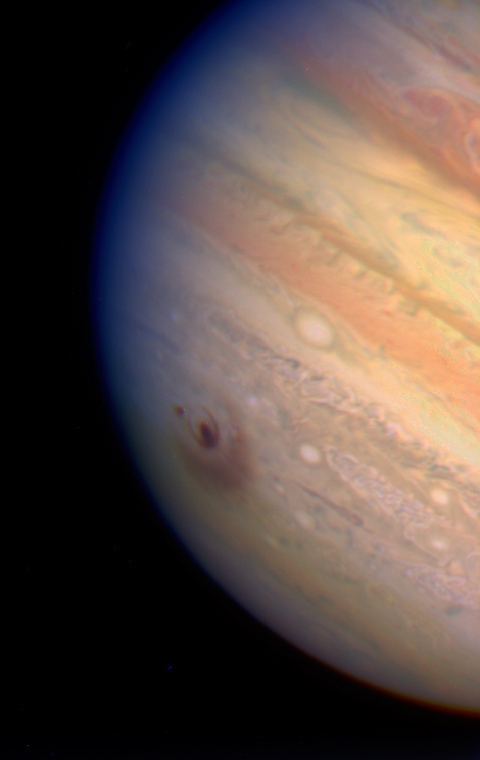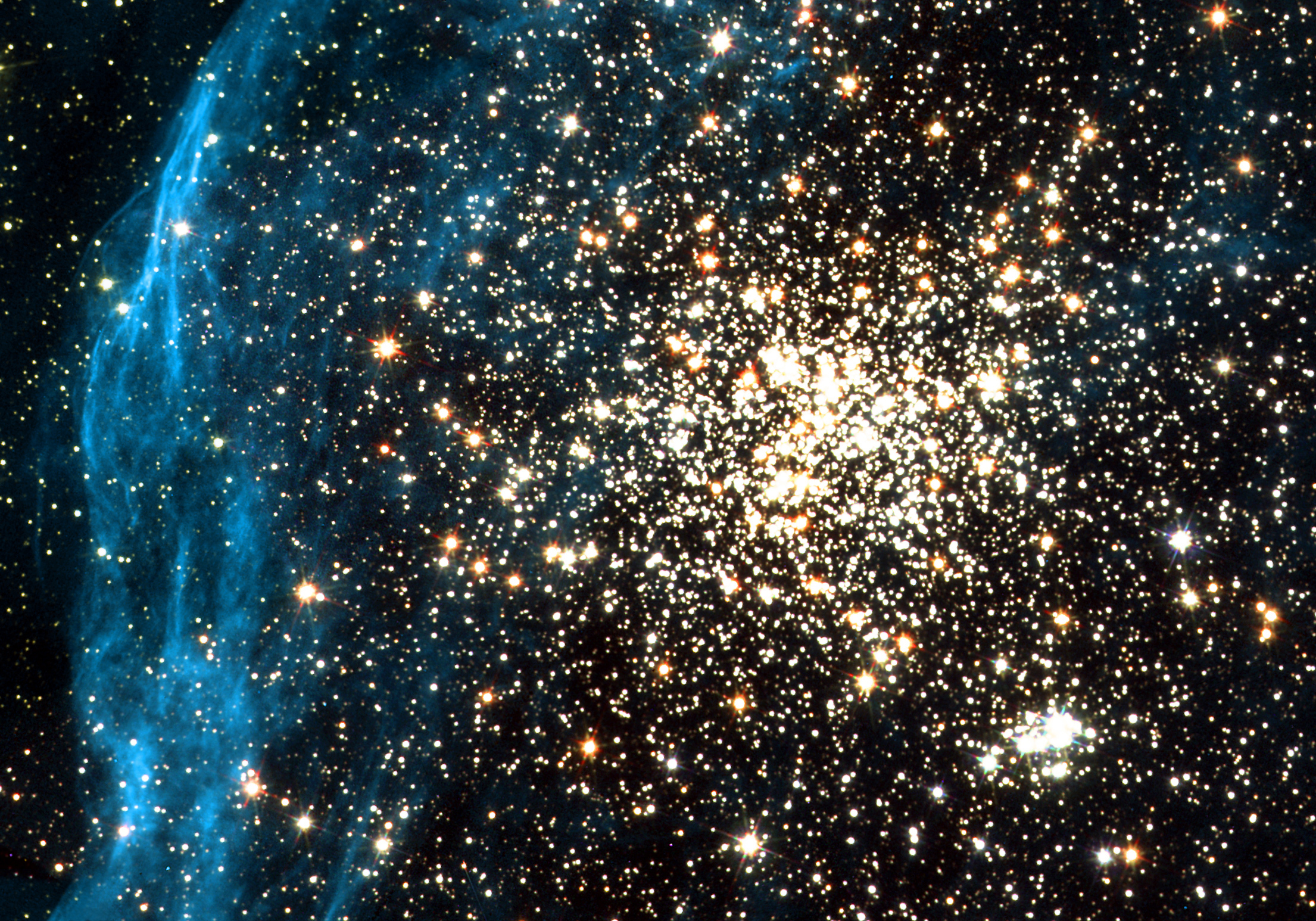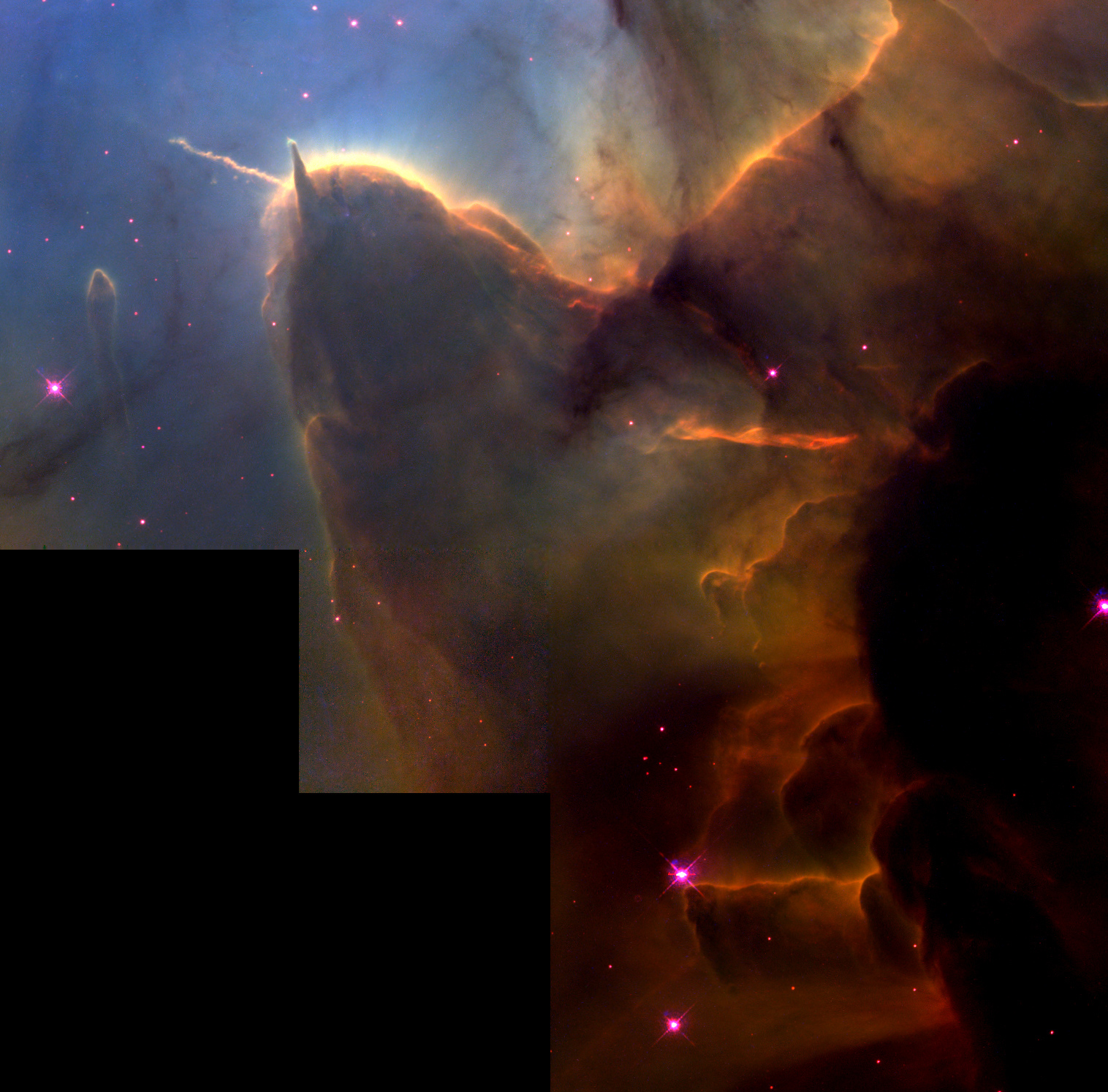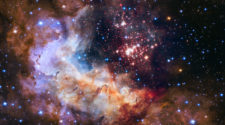
51. Reflection Nebula in Orion
Just weeks after NASA astronauts repaired the Hubble Space Telescope in December 1999, the Hubble Heritage Project snapped this picture of NGC 1999, a nebula in the constellation Orion. The Heritage astronomers, in collaboration with scientists in Texas and Ireland, used Hubble’s Wide Field Planetary Camera 2 (WFPC2) to obtain this colour image.

52. Jupiter impact zones from comet
This true colour image of the giant planet Jupiter, by NASA and ESA’s Hubble Space Telescope, reveals the impact sites of fragments ‘D’ and ‘G’ from Comet Shoemaker-Levy 9.

53. Bright quasar 3C 273
This image is likely the best of ancient and brilliant quasar 3C 273, which resides in a giant elliptical galaxy in the constellation of Virgo (The Virgin). Its light has taken some 2.5 billion years to reach us. Despite this great distance, it is still one of the closest quasars to our home. It was the first quasar ever to be identified, and was discovered in the early 1960s by astronomer Allan Sandage.
The term quasar is an abbreviation of the phrase “quasi-stellar radio source”, as they appear to be star-like on the sky. In fact, quasars are the intensely powerful centres of distant, active galaxies, powered by a huge disc of particles surrounding a supermassive black hole. As material from this disc falls inwards, some quasars — including 3C 273 — have been observed to fire off super-fast jets into the surrounding space. In this picture, one of these jets appears as a cloudy streak, measuring some 200 000 light-years in length.

54. Gaseous streamers flutter in stellar breeze
N44C is the designation for a region of ionized hydrogen gas surrounding an association of young stars in the Large Magellanic Cloud (LMC), a nearby, small companion galaxy to the Milky Way visible from the Southern Hemisphere. N44C is part of the larger N44 complex, which includes young, hot, massive stars, nebulae, and a ‘superbubble’ blown out by multiple supernova explosions.

55. Remarkable double cluster
Located in the Large Magellanic Cloud, one of our neighbouring dwarf galaxies, this young globular-like star cluster is surrounded by a pattern of filamentary nebulosity that is thought to have been created during supernova blasts. It consists of a main globular cluster in the centre and a younger, smaller cluster, seen below and to the right, composed of extremely hot, blue stars and fainter, red T-Tauri stars. This wide variety of stars allows a thorough study of star formation processes.
“Just last year, we carried out a massive program, one of Hubble’s largest, in which we obtained a series of spectra of an active galaxy, a quasar-like object with a central black hole that is actively accreting mass.
“We obtained one observation per day for half a year, allowing us to make a movie of how it evolves with time and how its inner structure changes.
“The data are beautiful and we’re only now in the early stages of trying to interpret it.”
Dr. Bradley M. Peterson and Dr. Gisella De Rosa
(Peterson) Professor and Chair of Astronomy, Ohio State University, Columbus, Ohio
(De Rosa) Visiting Astronomer, Space Telescope Science Institute, Baltimore, Maryland

56. Stellar sibling rivalry of the Trifid Nebula
Massive newborn stars are creating in this dramatic torn apart image of the Trifid Nebula.The Trifid Nebula is home to many thousands of newly created stars. The source of the jet is a young very hot star buried in the cloud.
This Hubble Space Telescope image of the Trifid Nebula reveals a stellar nursery being torn apart by radiation from a nearby, massive star.
The picture also provides a peek at embryonic stars forming within an ill-fated cloud of dust and gas, which is destined to be eaten away by the glare from the massive neighbor.
This stellar activity is a beautiful example of how the life cycles of stars like our Sun is intimately connected with their more powerful siblings.

57. Violent history of NGC 7714
NGC 7714 is a spiral galaxy 100 million light-years from Earth — a relatively close neighbour in cosmic terms.
The galaxy has witnessed some violent and dramatic events in its recent past. Tell-tale signs of this brutality can be seen in NGC 7714’s strangely shaped arms, and in the smoky golden haze that stretches out from the galactic centre — caused by an ongoing merger with its smaller galactic companion NGC 7715, which is out of the frame of this image.

58. Spiral galaxy M81
This Hubble Space Telescope photo shows the majestic spiral galaxy M81.
In the midsts of this galaxy is the supernova 1993J which was recently found to have a companion star which had been hidden in the glow of the supernova for 21 years.

59. Jupiter and its shrunken Great Red Spot
This full-disc image of Jupiter was taken on 21 April 2014 with Hubble’s Wide Field Camera 3 (WFC3).
“Hubble has imaged so many amazing sites in our vast Universe in its 25 years of exploring. It is no surprise that solar system science is represented in this Top 100, even though its is clearly weighted toward galaxies and nebulae. Gorgeous Jupiter made the cut four times, not only for its intrinsic beauty but also for its propensity to serve as a target for wayward asteroids and comets (and one serendipitous image with a large moon blocking the Great Red Spot). photogenic Saturn has been on everyone’s top 100 list, and Hubble is no exception, with Saturn appearing three times (once on its own, another time accompanied by some of its many moons, and a third time highlighting is UV aurorae). Comets themselves are always a solar system favorite, so it is no surprise that a comet makes the Hubble Top 100. No Hubble list would be complete without marvel Mars, with the Hubble image directly showing is polar ice caps and wispy thin atmosphere. I might have included an image of Neptune, of Uranus with the transit of its moon Ariel, one of the disintegrating asteroids, a comet tail. We could create a top 100 images just in the solar system.”
Dr. Jim Green
Planetary Science Division Director
NASA Headquarters
Washington, D.C.

60. Variable star RS Puppis
This Hubble image shows RS Puppis, a type of variable star known as a Cepheid variable. As variable stars go, Cepheids have comparatively long periods — RS Puppis, for example, varies in brightness by almost a factor of five every 40 or so days.
RS Puppis is unusual; this variable star is shrouded by thick, dark clouds of dust enabling a phenomenon known as a light echo to be shown with stunning clarity.
These Hubble observations show the ethereal object embedded in its dusty environment, set against a dark sky filled with background galaxies.



